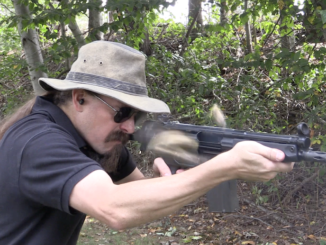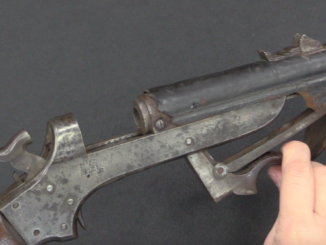One of the problems with using suppressors on machine guns is that suppressors or generally much more susceptible to heat buildup than the guns themselves. In 2019, US SOCOM put out a request for a suppressor that could handle a 600 round belt dump on an M240 machine gun. Radical Defense responded by developing a suppressor specifically designed for use with automatic fir, both in its materials and its mechanical design.
Mechanically, they took the concept of the Lewis Gun’s forced-air cooling and integrated it into their suppressor. The outside of the baffle stack is surrounded by a series of hollow channels running the length of the can. Muzzle blast from firing pulls cool outside air through these channels from back to front, cooling the unit. Interestingly, once the can hits about 450 degrees F, the temperature differential between inside and outside will actually generate this forced-air effect without any firing – dramatically increasing the can’s rate of cool-down. In testing, they found that a 600-round burst will heat the can (a 7.62mm version on an M240, specifically) up to 1565F, but 10 minutes later it will have dropped to 484F. After an additional 20 minutes, the can was down to ambient temperature.
From a materials standpoint, a very heat-resistant alloy was chosen. It is more than 50% nickel, with a significant portion of cobalt. This allows the can to withstand those extremely high temperatures generated by sustained fire. Manufacturing is done via laser sintering, allowing all the complex geometry of the suppressor baffles and cooling channels to be formed without the insanely complex machining fixtures and/or welding that would be required by traditional manufacturing processes. This is a very cool example of 3D printing technology being used to produce geometries that would be unfeasible just a few years ago.
The original design was in 7.62mm, for the M240. What I have in this video is the 5.56mm version, just the same thing scaled down for the M249. A version for the 12.7mm M2 is also in the works. The downsides to its capabilities are significant cost and weight (this 5.56mm version weighs 2lb 7oz). However, Radical is already developing a significantly lightened second generation of both sizes.
Thanks to Radical Defense for the loan of this example for filming! I saw them at SHOT Show and was really taken by the combination of century-old design concepts and totally cutting-edge manufacturing processes.




Very informative and interesting. Laser sintering? Had not heard of that before. Certainly sintering, as I worked in a metal working plant. Seriously? Nobody conceptually ever brought to market a suppressor using the Lewis cooling jacket? Wow. Thanks Ian.
How would this show up on thermal imaging?
Like a searchlight…
I am wondering if after getting “(…)heat(…)7.62mm version on an M240, specifically)(…)1565F(…)” it would not show glow to naked eye in cloudy night condition. I find table http://www.911research.wtc7.net/cache/wtc/analysis/fires/metcolor.htm which imply that when temperature reaches 1550 then color of metal becomes Salmon, though it did not explain which metal.
@Daweo, this table is a pretty poor reference. As you noted, it does not specify a particular material. Here is a chart for “steel”
https://www.sizes.com/materials/colors_of_heated_metals.htm
Again, steel being a much different substance than what is being used in this situation.
I would only draw a conclusion that the suppressor is “hot” but not a specific temperature range. As tempting as it may be.
The type of metal is not particularly important, as they all glow the same colour depending on their temperature. Not quite exact, but a good approximation, with the accuracy dependant on how well the material approximates a black-body. Look up “black-body radiation” for more on this.
Thanks for this video and all your others. Looking at this it seems that the muzzle end is shaped as a venturi which causes the flowing of the air thru while shooting as well as when super-heated, cool piece.
Time to upgrade to an M249 Ian…just saying. lol
Interestingly, the North American Aviation X-15 rocket plane was constructed largely from Nickel-Cobalt alloys (Inconel-X 750) which allowed it to attain speeds of over 6700 fps without melting the airframe. My great-aunt was a member of the team that evaluated the X-15 use by NACA.
Hmm,
Works as a ram jet once you get it warmed up and started…
Bit annoying if it whistles
By the same token, the technology might be a better way of making a noise-abatement tailpipe unit for airliner engines.
The “noise abatement turn” on climbout is still the bane of airline pilots.
cheers
eon
I do not know about airliner engines, but this reminded me about low noise exhaust for F-18 https://www.uc.edu/news/articles/2021/09/uc-engineers-quieter-jet-engines-for-fighter-planes.html but these are not destined to ease pilots works, but lessen deck crew fatigue.
“(…)version for the 12.7mm M2 is also in the works(…)”
Now I am wondering how they plan to solve issue cause by fact that said weapon is recoil rather than gas-operated like M240 and M249?
If there was ever an argument for hosting a commercial promotional video, this is it. This is an order of magnitude advance in firearms technology, not just another product.
*Please* ask them for some range video accompanied by time lapse thermal footage from their testing for a followup. Dual image showing it heat up in real time during firing followed by a clock and time lapse of the cool down.
The induced air flow is a result of the Bernoulli Principle. That equation is used extensively in hydraulics and aerodynamics. And, it looks suitable here. Very interesting.
https://en.wikipedia.org/wiki/Bernoulli%27s_principle
That business about the airflow continuing even after firing is over… I’m not buying it — not in the slightest. Okay, if you point the muzzle up you’ll get a chimney effect, but you’ll get that at any elevated temperature, not just when it’s really hot. Yes, energy is there to power airflow, but there’s no way of it doing so (except the chimney hot-air-rises thing). There’s a reason jet engines have compressors and turbines and not just combustion chambers. (Yes, ramjets don’t have those, but they only work at supersonic speeds.) No, Bernoulli doesn’t explain it. (It doesn’t even explain the part that does work, which is when the gun is firing: that’s entrainment of air, where air that’s moving sucks along neighboring air.) The thing taking ten minutes to cool down from ~1500F to ~500F seems about normal and not requiring any weird effects. (Things at high temperatures cool much faster, since thermal radiation is the dominant cooling mechanism and it scales as the fourth power of temperature.)
This is quite a neat device, but their marketing is going one bit of neat too far.
“(…)ramjets don’t have those, but they only work at supersonic speeds.(…)”
False, they were often used in such application during Cold War, but it is possible to build ramjet for subsonic flight as evidenced by Product 8
http://www.ram-home.com/ram-old/i-207-9.html
La-138 (max. speed at sea level 660 km/h)
http://www.airwar.ru/enc/xplane/la138.html
Leduc 0.10
https://aviastar.org/air/france/leduc_010.php
During the first flight, of 12 minutes duration, a speed of 680km/h was attained on half power.
Looking at those links, those ramjets only worked for very small values of “work”. They were experimental devices that only proved the point that a subsonic ramjet is not even remotely practical. Yes, you can get net thrust, but only at high subsonic speeds and at miserable efficiencies (since the compression ratio is quite low). That 680 km/h was probably mostly the result of diving; the plane certainly is described as starting out in a dive (launched from a carrier aircraft).
Where something like that was practical was with ducts around the cooling radiators of piston-engined fighter planes: those could be shaped to generate a little bit of extra thrust, or at least offset some of the drag of the radiator. Since all the hardware was going to be there in the first place and the heat was free, it was worth making the design effort to shape the ducts appropriately. The P-51 in particular is said to have done this.
Of course something that doesn’t really work for thrust and only disposes of heat is exactly what is wanted here. But the effect required the plane to actually be flying (which it did at over 400 mph).
By the way, there’s a way Ian could have tried this out without destroying any of his guns: heat the silencer up from the outside using a torch and then fire a short burst. He’s probably already returned it, though.
The geometries permitted by sintering/3d printing are mind blowing.
I can totally foresee a future generation of this design with internal cooling channels in the baffles themselves like turbine blades, radiator fins on top, some type of self circulating coolant medium to transfer heat such as lead, sodium, lithium, etc as used in some reactor designs, in addition to the air flow channels. The possibilities this opens up are endless. Add in a thermo-electric cell to trickle charge you optic’s batteries too. The future is going to be amazing.